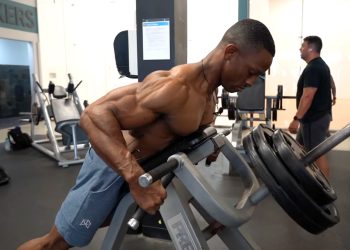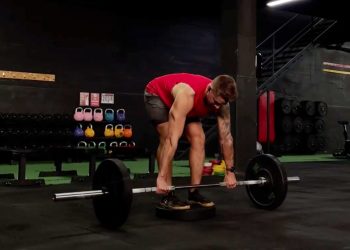The humble dumbbell is one of the most versatile training tools. You can use dumbbells to train for muscle size, strength, or endurance, and they’re great for circuit training and high-intensity interval training. Plus, they don’t occupy much space in your home gym.
As a personal trainer with over 35 years in the trenches, I’ve helped countless people transform their physiques with nothing but dumbbells. Most people think they need barbells and high-tech machines to train their backs optimally. I will debunk this myth through this article.
About the Experts Behind This Article:
Patrick Dale serves as the Training Editor at Fitness Volt. His background includes gym instruction, personal training, and service as a Royal Marine Commando. After leaving the military, he returned to the fitness world, mentoring new trainers and immersing himself in various athletic pursuits.
Tom Miller, a Certified Strength and Conditioning Specialist (CSCS), is Fitness Volt’s resident expert on fitness and conditioning. His rigorous review process ensures that our content is accurate, reliable, and meets the highest standards.
Recent Updates: On May 24, 2024, Fitness Volt’s Senior Editor Vidur Saini (ACE-CPT) revised the list to include only the 12 most effective and proven back exercises. We also added actionable training tips and updated this piece to enhance readability. Level Up Your Fitness: Join our 💪 strong community in Fitness Volt Newsletter. Get daily inspiration, expert-backed workouts, nutrition tips, the latest in strength sports, and the support you need to reach your goals. Subscribe for free!
Best Dumbbell Back Exercises
Here are 12 of the best dumbbell exercises you can do for your upper, lower, and mid-back.
- Dumbbell Bent-over Row
- Dumbbell Yates Row
- Dumbbell Single-Arm Row
- Kroc Row
- Dumbbell Pendlay Row
- Dumbbell Wrestler’s Row
- Dumbbell Romanian Deadlift
- Dumbbell Good Morning
- Dumbbell Reverse Fly
- Dumbbell Chest-Supported Row
- Dumbbell Pullover
- Dumbbell Seal Row
1. Dumbbell Bent-Over Row
| Sets & Reps | Equipment Needed | Target Muscles |
| 3-4 x 8-12 | Dumbbells | Lats, rhomboids, traps, rear delts, biceps |
Two-handed rows are usually done with a barbell. While that exercise certainly works, there is a disadvantage: you can only pull the bar back until it touches your body. Using dumbbells means you can row with a larger range of motion, which may increase muscle activation.
“Using dumbbells also allows a more natural wrist position, which can make this pulling exercise kinder on your wrist, elbows, and shoulder joints,” said Saini.
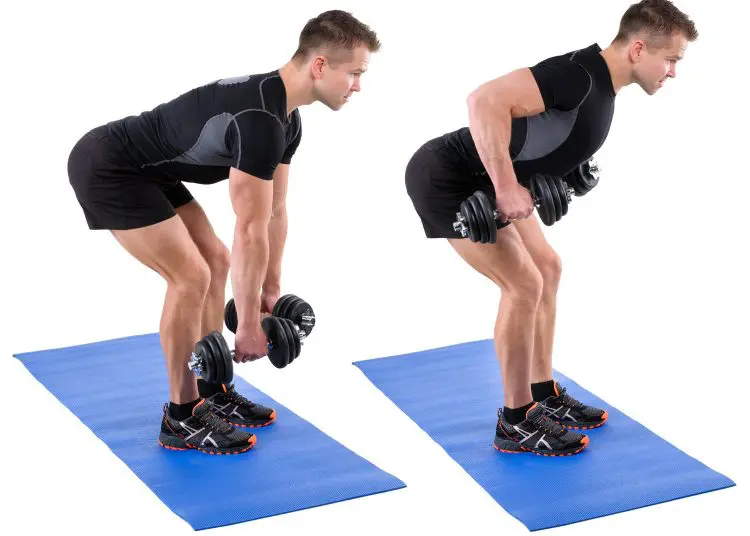
How to do it:
- Grab a pair of dumbbells with a neutral or overhand grip while keeping your feet shoulder-width apart.
- Bend your knees slightly while bringing your torso forward until it is almost parallel to the ground.
- Keep your core tight and back straight.
- Retract the scapula and pull the dumbbell to your sides while feeling the contraction in the mid-back and lats.
- Lower the dumbbells slowly while exhaling.
- Repeat for 8-10 reps.
Pro Tips: Try the overhand and neutral grip to check what works better. Keeping the elbows close to the body allows better lats activation, and a wide elbow positioning will result in greater upper-back activation.
Benefits of the dumbbell bent-over row
- It’s a compound movement that activates almost every muscle on the posterior chain.
- A dumbbell bent-over row allows a greater range of motion.
| Difficulty | Progression | Regression |
| Intermediate | Barbell Bent-Over Row, Pendlay Row | Single-Arm Row |
Learn how to do dumbbell bent-over rows here.
2. Dumbbell Yates Row
| Sets & Reps | Equipment Needed | Target Muscles |
| 3-4 x 8-12 | Dumbbells | Traps, rhomboids, lats, biceps |
Although the Yates row is usually done with a barbell, it works just as well with dumbbells. Named after the six-time Mr. Olympia Doran Yates, this bent-over row exercise involves a more conservative back angle, making it a little more lower back-friendly than regular bent-over rows.
Yates had one of the best backs in bodybuilding; this exercise worked for him and will work for you, too.
How to do it:
Set-up: Get a pair of heavy dumbbells and place them on a bench.
- Hold the dumbbells with a supinated grip while maintaining a strong core.
- Keep your feet shoulder-width apart for better balance.
- Slightly bend your knees and lean forward so your torso is at 70 degrees.
- Keep your back straight and chest up.
- Pull the dumbbell towards your sides by retracting your shoulder blades and pulling your elbows towards the ceiling.
- Control the eccentric movement while maintaining a strong core.
Pro Tips: Pause for a second at the bottom of the movement to experience a greater stretch in your upper back.
Benefits of the dumbbell yates row
- It allows you to go heavy.
- Emphasize upper back strength.
- Builds bigger biceps and grip strength.
| Difficulty | Progression | Regression |
| Advanced | Barbell Yates Row, Increased Weight | Single-Arm Row, Chest-Supported Row |
Find out more about Yates rows in our in-depth guide.
3. Dumbbell Single-Arm Row
| Sets & Reps | Equipment Needed | Target Muscles |
| 3-4 x 8-12 (each arm) | Dumbbell | Lats, rhomboids, traps, rear delts, biceps, core (anti-rotation) |
Single-arm dumbbell rows are a classic back builder and allow you to focus on one side of your body at a time, resulting in a better mind-muscle connection. As an added advantage, you only need one dumbbell for this exercise.
Begin the movement by retracting the scapula before flexing the elbows, recommends Saini.
How to do it:
- Bend at your hips and place your right hand at one end of a flat bench and your right knee on the other.
- Your torso should be parallel to the floor.
- Grab a dumbbell in your left hand with a neutral grip.
- Exhale and pull up the dumbbell to the side of your chest by flexing and keeping your elbow close to the body.
- Slowly bring down the dumbbell to the starting position.
- Repeat for recommended reps before switching sides.
Pro Tips: Squeeze the shoulder blade down and back at the top of the movement, as if you’re tucking it into your back pocket. This maximizes lat engagement and helps prevent the traps from taking over.
Benefits of Single-arm rows
- Unilateral movement helps fix muscle and strength imbalances.
- It helps in achieving better lats isolation.
- Reduces stress on the lower back and improves core strength.
- Allows a higher range of motion.
| Difficulty | Progression | Regression |
| Beginner | Bent-Over Row, Increased Weight, Unilateral Landmine Row | Kneeling Single-Arm Row, TRX Row |
Learn how to do this classic back builder here.
4. Kroc Row
| Sets & Reps | Equipment Needed | Target Muscles |
| 3-4 x 15-20 (each arm) | Dumbbell | Lats, biceps, forearms, traps |
Kroc rows are an extreme version of single-arm dumbbell rows. With this variation, you use a very heavy weight and your legs and lower back to help you crank out your reps. Although it can be considered cheating by conventional bodybuilding standards, it’s a potent back size and strength-building exercise.
Named after powerlifter and bodybuilder Janae Marie Kroc, this is an advanced exercise, so make sure you have mastered standard single-arm rows before you try it.
Saini suggests exploding on the concentric (pulling) phase, then controlling the eccentric (lowering) phase for a full 2-3 seconds.

How to do it:
- Stand next to a stable platform such as a weights rack or a bench.
- Lean forward to angle the torso around 30-45 degrees from the floor.
- Have your left leg in front and your right leg behind to add stability.
- Grab the dumbbell with your right hand with a neutral grip. You can also use lifting straps.
- Retract your shoulder blades and pull the dumbbell with your back. Avoid using the biceps.
Pro Tips: Focus on controlled negatives and maximum stretch.
Benefits of Kroc Row
- Builds explosive rowing strength.
- Excellent mass-building exercise.
- Increases grip strength.
- Corrects muscle imbalance between sides.
| Difficulty | Progression | Regression |
| Advanced | Increased Weight, More Repetitions | Single-Arm Row with lighter weight |
Read more about Kroc rows in this article.
5. Dumbbell Pendlay Row
| Sets & Reps | Equipment Needed | Target Muscles |
| 3-4 x 6-8 | Dumbbells | Lats, rhomboids, traps, rear delts, biceps |
Pendlay rows, or dead-stop rows, are named after powerlifting and Olympic weightlifting coach Glen Pendlay. With this dumbbell back exercise, you rest the weight on the floor between reps, which gives your grip and lower back a short rest.
This should allow you to lift heavier weights or do more reps than regular bent-over rows. You can do dumbbell Pendlay rows using two dumbbells or one arm at a time.
“Reset your form at the bottom of each rep,” said Saini. “The explosive start targets fast-twitch muscle fibers, promoting strength and power gains.”
How to do it:
- Set a pair of dumbbells on the floor at shoulder width.
- Bend over so your torso is parallel to the ground.
- Grab the dumbbells with an overhand grip while engaging your core.
- Use your lats to explosively pull the dumbbells towards your sides.
- Lower the dumbbells to the ground.
- Brace your core again and repeat the pull for a few reps.
Pro Tips: Do some core activation drills (bird-dog exercise) before you perform this exercise.
Benefits of the dumbbell pendlay row
- Improve the explosive strength of lats.
- Improves the core engagement and rowing technique.
- Creates a strong foundation for heavier deadlifts and squats.
| Difficulty | Progression | Regression |
| Advanced | Barbell Pendlay Row, Increased Weight | Bent-Over Row, Single-Arm Row |
Learn how to do dumbbell Pendlay rows here.
6. Dumbbell Wrestler’s Row
| Sets & Reps | Equipment Needed | Target Muscles |
| 3-4 x 8-12 | Dumbbells | Lats, rhomboids, traps, rear delts, biceps, core |
The best thing about the dumbbell wrestler’s row is that it makes light weights feel a whole lot heavier, so it’s ideal for home workouts when you’ve only got small dumbbells to train with. This is an excellent postural exercise that will also help strengthen your mind-muscle connection.
How to do it:
- Stand with your feet about hip-width apart and a dumbbell in each hand. Bend your knees slightly without rounding your lower back, and lean forward until your torso is inclined to about 45 degrees. Row both dumbbells up and into your ribs. This is your starting position.
- Keeping one arm stationary, extend one arm, and then row the weight back up.
- Lower the other weight and pull it back in.
- Continue alternating arms for the duration of your set.
- Make sure you keep your non-working arm pulled in tight; really flex that back!
Pro Tips: Core engagement is the key here. Start with a lighter dumbbell and slowly progress towards a heavier weight.
Benefits of dumbbell wrestler row
- It’s an anti-rotational movement that works on core stability.
- It’s a functional exercise that improves sports performance and muscle coordination.
- Decrease the risk of injuries by overcoming torso imbalance and poor movement.
| Difficulty | Progression | Regression |
| Intermediate | Renegade Row, Increased Weight | Bent-Over Row, Single-Arm Row |
7. Dumbbell Romanian Deadlift
| Sets & Reps | Equipment Needed | Target Muscles |
| 3-4 x 8-12 | Dumbbells | Hamstrings, glutes, erector spinae |
Most people do Romanian deadlifts to work their glutes and hamstrings. However, this exercise is equally useful for the lower back. You can do it with a barbell, but dumbbells are often more comfortable.
Saini recommends placing the balls of your feet on a squat wedge and heels on the floor for a deep erector spinae stretch at the bottom of your range of motion (ROM).
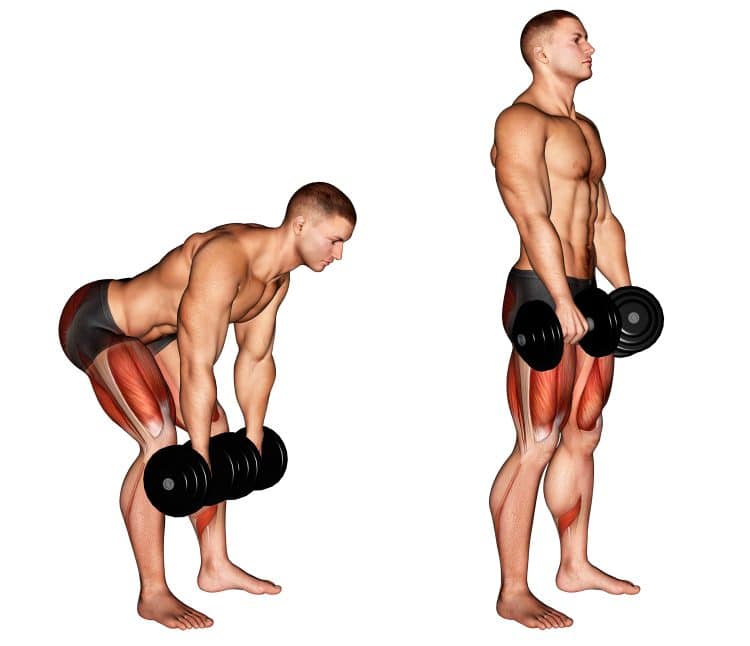
How to do it:
- Hold a dumbbell in each hand in front of your thighs. Your palms should be facing your legs.
- Bend your knees slightly and, without rounding your lower back, push your hips backward and lean forward. Lower the weights as far down the front of your legs as your flexibility allows.
- Stand back up and repeat, taking care not to lean back at the top.
Benefits of the dumbbell Romanian deadlift
- Builds muscle mass and strength.
- Improves grip strength.
- The body’s center of gravity stays closer to the body.
- It’s a beginner-friendly version of the deadlift.
| Difficulty | Progression | Regression |
| Beginner | Barbell RDL | Single-Leg RDL, Hip Hinge |
8. Dumbbell Good Morning
| Sets & Reps | Equipment Needed | Target Muscles |
| 3-4 x 8-12 | Dumbbell | Hamstrings, glutes, erector spinae |
Good mornings are more often done with a barbell but are considerably more comfortable and every bit as effective when you do it with a single dumbbell. You could also place the dumbbell on the back of your neck in this exercise.
How to do it:
- Hold a single dumbbell in front of your chest with both your hands. Stand with your feet about hip-width apart, knees slightly bent. Brace your abs.
- Without rounding your lower back, push your hips back and lean forward as far as your flexibility allows.
- Stand back up and repeat.
Pro Tips: Little pause at the bottom will help glute activation and mind-muscle connection.
Benefits of Dumbbell good morning
- Strengthen the whole posterior chain in one movement.
- Improves functional strength that aids in squatting and deadlift performance.
- Good morning is a hip hinge exercise that improves hip strength and mobility.
| Difficulty | Progression | Regression |
| Intermediate | Barbell Good Morning | Bodyweight Good Morning, Hip Hinge |
9. Dumbbell Reverse Fly
| Sets & Reps | Equipment Needed | Target Muscles |
| 3-4 x 12-15 | Dumbbells | Rear delts, rhomboids, middle traps |
The reverse fly is an excellent exercise for better posture. It works your posterior deltoids, middle traps, and rhomboids and can help pull your shoulders back and undo some of the effects of hunching over a computer or phone all day. It’s also good for your general shoulder health.
Pause at the top of the movement with your shoulder blades retracted. This peak contraction intensifies muscle activation and reinforces proper form, suggests Saini.
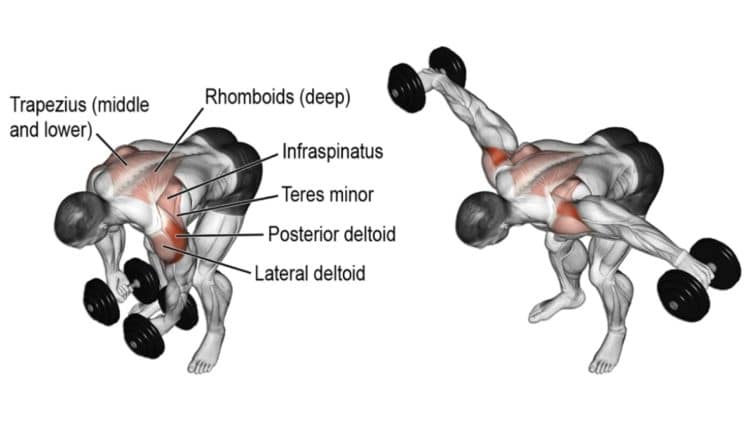
How to do it:
- Stand with your feet hip-width apart. Hold a pair of dumbbells in a neutral grip.
- Hinge forward by pushing your hips back.
- Maintain the arc in your back while getting almost parallel to the floor.
- Now lift your arms to your sides so they are in line with your torso and parallel to the floor.
- Control the eccentric motion to bring the dumbbells back to starting position.
Pro Tips: Don’t try to go heavy. Maintain complete control over the motion by controlling the tempo.
Benefits of dumbbell reverse fly
- Strengthens upper back and posterior delts.
- It’s an excellent exercise for scapular strengthening.
| Difficulty | Progression | Regression |
| Intermediate | Cable Reverse Fly | Band Pull-Apart |
Check out our guide and learn to do dumbbell reverse flyes correctly.
10. Dumbbell Chest-Supported Row
| Sets & Reps | Equipment Needed | Target Muscles |
| 3-4 x 8-12 | Dumbbells, Incline Bench | Lats, rhomboids, traps, rear delts, biceps |
Most dumbbell rowing exercises put a lot of pressure on your lower back. That can be a good thing as it will help strengthen this all-important area. However, if your lower back is tired or sore, you might appreciate a more lower-back-friendly exercise.
Chest-supported dumbbell rows take your lower back out of your workout, leaving you free to focus on training your upper back and biceps.
How to do it:
- Set an incline bench at 45 degrees.
- Now grab a pair of dumbbells and place your chest against the bench.
- Hold the dumbbells with a neutral grip.
- Now retract the scapula and pull your elbows upward to lift the weight.
- Control the tempo as you bring the dumbbells back down.
- Repeat the movement for 12 reps.
Pro Tips: Pause for a second at the bottom. It allows greater muscle engagement.
Benefits of the chest-supported row
- Eliminates the chances of back pain or injuries.
- It is considerably easier for beginners.
- It’s easy to anchor the torso in the correct position.
- Better isolation of back muscles.
| Difficulty | Progression | Regression |
| Beginner | Machine T-Bar Row | Bent-Over Row with lighter weight |
11. Dumbbell Pullover
| Sets & Reps | Equipment Needed | Target Muscles |
| 3-4 x 10-15 | Dumbbell, Bench | Lats, chest, triceps |
Many lifters view the dumbbell pullover as a chest exercise, but you can tweak your exercise form to load the lats.
Saini advises keeping a slight bend in your elbows throughout the movement. This takes stress off your joints and allows for a greater stretch in the lats.
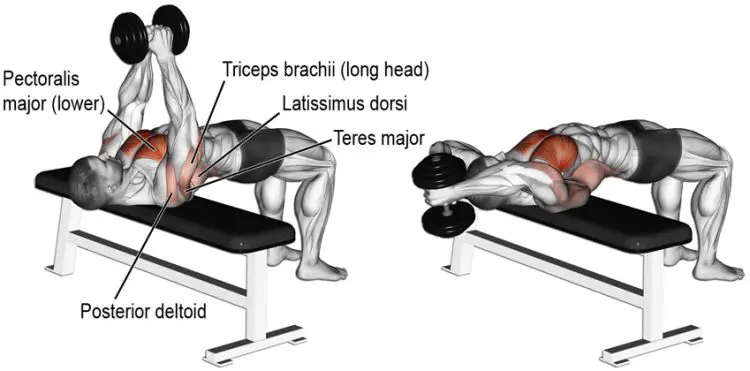
How to do it:
- Lie on the bench while holding a single dumbbell with both hands.
- Keep your elbows slightly bent as you hold the dumbbell over your chest.
- Maintain a slight arch in your back to open up your lats.
- Lower the weight behind and go down as low as you can.
- Once you get to the bottom, you have to pull the dumbbell up to get into the starting position.
Pro Tips: Flare your elbows slightly wider to have better lat activation.
Benefits of dumbbell pullover
- Engage the core, shoulders, back, and chest.
- It’s also a great exercise to improve shoulder mobility.
| Difficulty | Progression | Regression |
| Beginner | Straight-Arm Pulldown | Assisted Pullover with band |
12. Dumbbell Seal Row
| Sets & Reps | Equipment Needed | Target Muscles |
| 3-4 x 8-12 | Dumbbells, Bench (or elevated surface) | Lats, rhomboids, traps, rear delts, biceps |
The seal row is an excellent exercise that biases the upper back and lats.
There are benches explicitly made for the seal row, but if you don’t have one in your gym, then you can increase the height of the available bench by placing a few weight plates under it on each side.
How to do it:
- Increase the height of the bench to achieve a full range of motion.
- Lie with your chest on the bench with the dumbbells placed on the floor.
- Grab the dumbbells with an overhand grip.
- Retract your shoulder blades and pull the weight up by lifting your elbows towards the ceiling.
- Hold the contraction for two seconds.
- Return to the starting position.
- Repeat for the recommended reps.
Pro Tip: Focus on a controlled eccentric motion for achieving hypertrophy.
Benefits of dumbbell seal row
- It allows you to train your back without using momentum.
- Beneficial for people who struggle with poor form or back pain.
- It also strengthens the rotator cuff.
| Difficulty | Progression | Regression |
| Intermediate | Barbell Seal Row, Increased Weight | Bent-Over Row with lighter weight, Inverted Row |
Important Training Variables
Training variables can bring variety to the workout.
Primarily, there are two training variables that you need to know: Body positioning and grip variation. Let’s get to know each in detail.
Grip Variations
Using dumbbells, you can train with an underhand grip, overhand grip, neutral grip, or rotating grip. Let’s understand how different grips have different impacts on your back muscles:
- Underhand grip: Underhand grip emphasizes more on your lats and biceps. The underhand grip usually feels easier because of the greater biceps involvement.
- Overhand grip: Overhand grip emphasizes the development of traps, rhomboids, rear delts, teres major, and brachioradialis.
- Neutral grip: Neutral grip helps in achieving better lat stretch. It targets all the back muscles evenly.
- Rotating grip: Many experienced lifters rotate their grip during a pulling motion. Rotation improves overall upper body development by engaging more muscle fibers.
Dumbbell rotation enhances functional ability and allows deeper stretch during the workout.
Body Positioning
Here is how to train different back muscles by adjusting your torso position.
Positioning your torso parallel to the ground: You can make your upper body parallel to the floor by setting up a bench for a seal row or hinging at your hips for a bend-over row. Placing your torso parallel to the ground allows maximum attention to mid-back and lats development.
Level Up Your Fitness: Join our 💪 strong community in Fitness Volt Newsletter. Get daily inspiration, expert-backed workouts, nutrition tips, the latest in strength sports, and the support you need to reach your goals. Subscribe for free!
Positioning your torso 45 degrees to the ground: Set a weight bench at a 45-degree incline and lie face down on it. This placement enables traps, rhomboids, rear delts, teres major, and lats activation.
Positioning your torso upright: It will develop upper traps and neck. A dumbbell shrug is a classic example.
Dumbbell Back Workout
Not sure where to start doing back exercises at home with dumbbells? Need a dumbbell workout for your back the next time you hit the gym?
No problem; we’ve got you covered!
Do the following training program 1-2 times per week. If you do it twice, make sure you allow a few days for recovery and muscle growth, e.g., Monday and Thursday. Before you start, remember to warm up. A thorough warm-up will reduce your risk of injury and increase your workout effectiveness.
Jog or jump rope for 5-10 minutes, and then do a few joint mobility and dynamic flexibility exercises for the body parts you are about to train.
Pay extra attention to your lower back. Finish your warm-up with a few light sets of the first 1-2 exercises of the workout.
| Exercise | Sets | Reps | Recovery | |
| 1 | Dumbbell bent-over row | 2-4 | 6-12 | 60-90 seconds |
| 2 | Dumbbell single-arm row | 2-4 | 6-12 per arm | 60-90 seconds |
| 3 | Dumbbell Yates row | 2-4 | 6-12 per arm | 60-90 seconds |
| 4 | Dumbbell chest support row | 2-4 | 6-12 | 60-90 seconds |
| 5 | Dumbbell RDL | 2-4 | 6-12 | 60-90 seconds |
| 6 | Dumbbell good morning | 2-4 | 6-12 | 60-90 seconds |
Watch the best dumbbell exercises by Fitness Volt experts below:
Dumbbell Back Workout For Beginners
Dumbbell-only back workout can help you make decent progress toward your fitness goal.
Not all exercises are created equal. While some are beginner-friendly, others require a decent amount of practice.
Our dumbbell-only back workout is specially curated for beginners, and it can help you build strength and improve your posture.
Make sure that you start with lightweight dumbbells and slowly progress your way to heavier dumbbells.
| Exercise | Sets | Reps | Rest Period | |
| 1. | Single-Arm Dumbbell Row | 3 | 12 per arm | 60 seconds |
| 2. | Chest-Supported Dumbbell Row | 4 | 10-15 | 90 seconds |
| 3. | Dumbbell Reverse Fly | 4 | 8-10 | 60 seconds |
| 4. | Dumbbell Pullover | 3 | 8 per arm | 90 seconds |
| 5. | Dumbbell Seal Row | 3 | 12-15 | 60 seconds |
Dumbbell Back Workout Without a Bench
Don’t let the unavailability of a bench stop you from training your back. Here is how to train the back without a bench.
| Exercise | Sets | Reps | Rest Period | |
| 1. | Dumbbell Bent-Over Row | 4 | 12 | 90 seconds |
| 2. | Krock Row | 4 | 10-15 per arm | 90 seconds |
| 3. | Dumbbell Wrestler’s Row | 4 | 8-10 per arm | 60 seconds |
| 4. | Dumbbell Good Morning | 3 | 10-12 | 60 seconds |
| 5. | Dumbbell RDL | 3 | 12-15 | 90 seconds |
| 6 | Dumbbell Pendlay Row | 3 | 10-15 | 60 seconds |
Single Dumbbell Back Workout
Don’t have tons of weight at home? No worries, you can still achieve a lot with just one dumbbell.
We will not mention the rep range because your dumbbell size may differ. Train to failure.
| Exercise | Sets | Rest Period | |
| 1. | Single-Arm Dumbbell Row | 4 | 90 seconds |
| 2. | Dumbbell Pullover | 4 | 90 seconds |
| 3. | Kroc Row | 3 | 60 seconds |
| 4. | Unilateral Bent-Over Row | 3 | 60 seconds |
| 5. | Dumbbell Good Morning | 3 | 60 seconds |
| 6 | Dumbbell Single-Arm Seal Row | 3 | 60 seconds |
How To Intensify Workout Without Adding Weight?
You need to follow the progressive overload principle to build muscle mass and strength. However, many lifters misinterpret the true meaning of progressive overload. You don’t necessarily need to lift heavier to witness progress. .
Ramping up the intensity can be a great choice to get stronger without adding more weight.
Intensifying your workout without lifting heavier is a great way to bring quality to your workout. Here are four ways to make your workout more effective:
1. Increase the TuT (Time Under Tension):
Time under tension is the time a muscle is under tension during a set.
Many lifters are so obsessed with the amount of weight they lift that they completely neglect the TuT.
A 2016 study found positive benefits of greater time under tension. Test subjects were made to complete two training protocols, matched for intensity (% one-repetition maximum; 1RM), number of sets, number of repetitions, and rest intervals. One group was asked to perform the exercise with a rep duration of four seconds (two seconds concentric: two seconds eccentric; 2:2 protocol), and another group was asked to have a repetition duration of 6 seconds (two seconds concentric: four seconds eccentric; 2:4 protocol). [1]
The group that followed the 2:4 protocol with a rep duration of six seconds was observed to induce superior muscle hypertrophy.
Slowing down the rep tempo is a practical way to make your muscles work harder. Time under tension can be increased by slowing down the rep tempo or by holding the squeeze.
2. Shorten the Rest Period
Shortening the rest period between sets helps improve muscular endurance and achieve better muscle pump.
According to a 2009 study, when the training goal is muscular hypertrophy, the combination of moderate-intensity sets with short rest intervals of 30-60 seconds might be most effective due to greater acute levels of growth hormone during such workouts. [2]
3. Add Volume
Adding volume is an effective way to increase workout intensity.
German Volume Training is a famous high-volume training method that offers serious strength and hypertrophy benefits. German volume training involves doing 10 sets of 10 reps with the same weight, and the rest period should not be more than 90 seconds.
High-volume training improves muscle strength and endurance simultaneously.
4. Range of Motion
If you aren’t following a full range of motion, you are leaving substantial gains on the table. Optimizing range of motion is key to achieving muscle hypertrophy.
Benefits of Training With Dumbbells
Frankly, dumbbells don’t get enough credit. Many lifters are naturally inclined towards barbell training because of the sheer amount of weight they can lift with a barbell.
Why does training with barbells feels easier than with dumbbells?
Although barbells are harder to load and unload, they are easier to lift due to better muscle stabilization. Dumbbells could feel heavier because they need greater muscle stabilization. Performing a lift with a dumbbell in each hand results in greater muscle stabilizer recruitment than lifting a barbell weight with both hands. Example: Performing a conventional deadlift with dumbbells requires more muscle stabilization and balance than doing the same deadlift with a barbell.
Training with a pair of dumbbells might feel more challenging in certain exercises than using a barbell, but dumbbells offer added benefits. Let’s talk about some added benefits of training with dumbbells:
1. Dumbbells Are Joint Friendly
Dumbbells can take your training to the next level; you have an option for underhand, overhand, and neutral grip. Besides, you can alter the range of motion by changing the elbow position from wide to narrow. On the other hand, training with barbells allows a restricted range of motion because the actual axis of the barbell gets in the way.
When you grip the barbell, your wrists are locked in a certain position, which leads to a limited range of motion. Whereas, when you train with dumbbells, you can tweak your grip, elbow positioning, and scapular mobility according to the movement, making dumbbells a more joint-friendly choice.
Locking yourself in a particular range of motion can be really stressful on weak joints. Dumbbells tackle this issue by supporting range of motion modification.
2. Better Mind-Muscle Connection
Are you someone who finds it challenging to feel the target muscle while training? Inexperienced lifters often find it difficult to establish a mind-muscle connection, especially when training their back. Unlike the chest, shoulders, quads, and biceps, the back is not a ‘mirror muscle’ as a lifter cannot look at the target muscle directly in the mirror while training.
Dumbbells enhance muscle contraction by allowing a natural movement pattern, grip, and load selection.
3. Train Unilaterally
Muscle imbalance can hamper athletic performance and increase the chance of injuries. Bilateral movements like squats, deadlifts, and bench press improve the overall strength but often amplify muscle imbalance.
Unilateral training involves using a single arm or a single leg, which not only strengthens the stabilizers but also uncovers a lagging muscle group.
Muscle imbalance can be corrected by introducing unilateral dumbbell training to your routine.
4. Easier to use
Dumbbells are easier to set up and train. You don’t need a spotter to rescue you from a failed rep. Plus, you do not need to spend time racking and re-racking the barbell plates.
Performing drop-set is way easier with dumbbells.
Related: Barbells vs. Dumbbells: Which is Best?
Back Anatomy
Back is a bit of an oversimplification of the muscles on the rear of your body. Your back is made up of several important muscles and muscle groups and, if you want to look your best from the rear, you need to train all of them.
The primary muscles that make up your back are:
Latissimus dorsi – known as the lats for short, this is the largest muscle in your back. It’s located on the side of your torso, and its primary functions are adduction and extension of the shoulder joint. When well-developed, it’s your lats that give your back its width and V-shaped taper.
Rhomboids and mid-traps – the rhomboids and mid-traps are located between and across your scapulae or shoulder blades. They give your upper back its thickness and also play an important role in posture and shoulder stability.
Upper traps – the upper traps are heavily involved in many upper back exercises. The upper traps are responsible for the elevation of your shoulder girdle. Shrugging movements are usually the best way to train your upper traps.
Posterior deltoids – it’s hard to train your back without hitting your rear deltoids too. That’s good news because, for a lot of lifters, the posterior deltoids are woefully underdeveloped and would benefit from some extra training.
Erector spinae – the collective name for the group of muscles that stabilize and extend your spine. You can use dumbbells to specifically target your lower back, but they’re often used indirectly, such as when you lean forward to do bent-over rows.
More Plyometric Training Tips
Whether you’re new to back workouts or seeking advanced insights, knowledge is key. Explore more articles on back training to enhance your strength and routine.
- 30 Best Back Exercises
- Best Back Exercises at Home + Workout
- Best Rowing Exercises To Build Muscle Mass
- Inverted Rows at Home for Strong Back
- Best Upper Back Exercises
- Exercises for Back Fat
- Best Old-School Back Workouts
- Best Back Exercises for Building Muscle Strength and Size
Wrapping Up
Whether you train at home or in a gym, dumbbells are a valuable and versatile training tool. You can use them to build muscle size or strength, or just improve your fitness and control your weight. There really is nothing dumb about dumbbells!
A lot of exercisers find that training with dumbbells causes fewer joint aches and pains, and they’re especially shoulder-friendly. Plus, they’re good for improving your balance, stability, and coordination too.
Use these 12 dumbbell exercises to build your ultimate back. From top to bottom and side to side, these dumbbell back exercises are tough to beat!
References
- Martins-Costa HC, Ribeiro Diniz RC, Vitor Lima F, Machado SC, Valle de Almeida RS, Pereira de Andrade AG, Chagas MH. Longer repetition duration increases muscle activation and blood lactate response in matched resistance training protocols. Motriz: rev. educ. fis. 22 (1) • Mar 2016. Doi: /10.1590/S1980-65742016000100005
- de Salles BF, Simão R, Miranda F, Novaes Jda S, Lemos A, Willardson JM. Rest interval between sets in strength training. Sports Med. 2009;39(9):765-77. doi: 10.2165/11315230-000000000-00000. PMID: 19691365.








